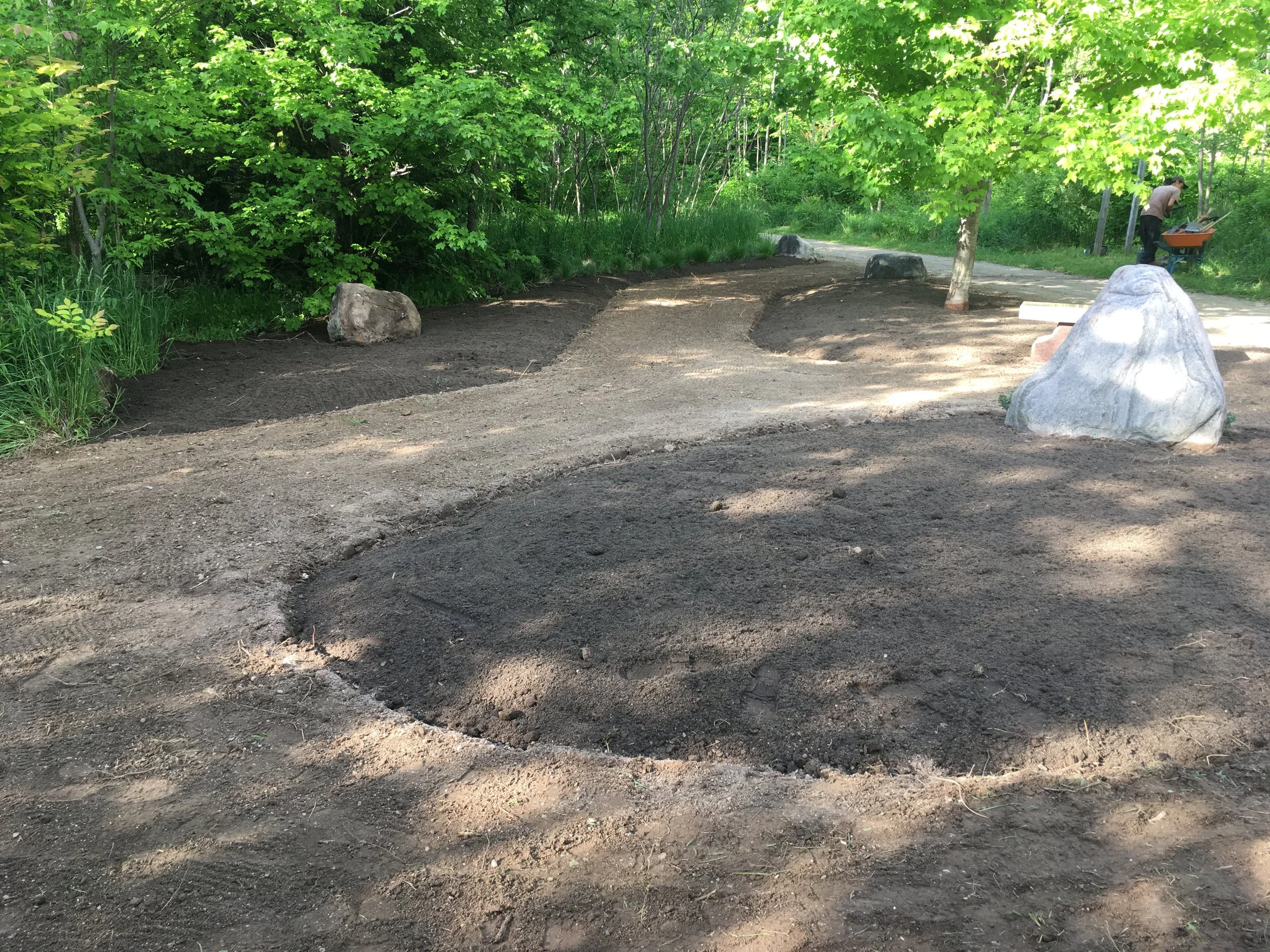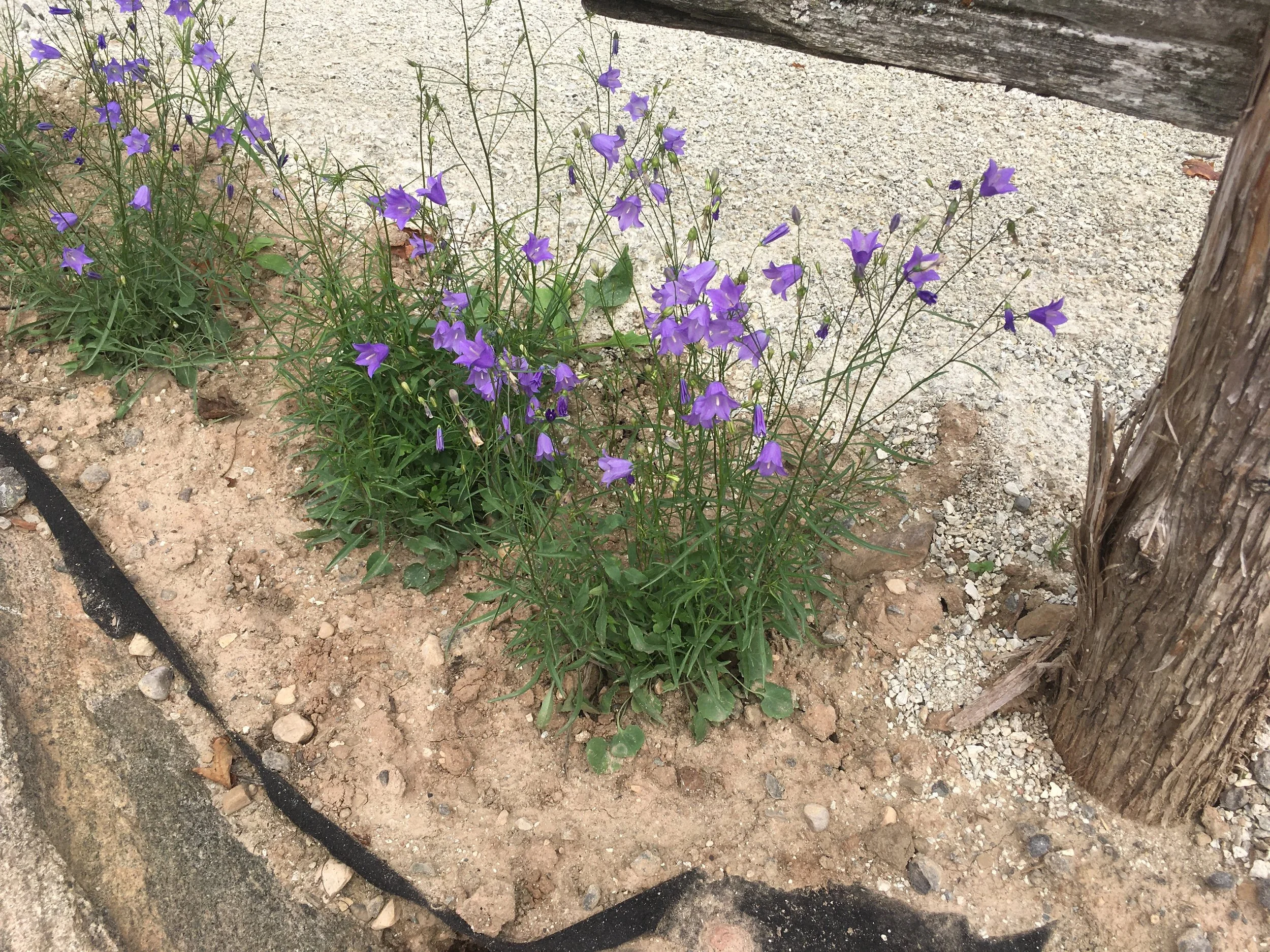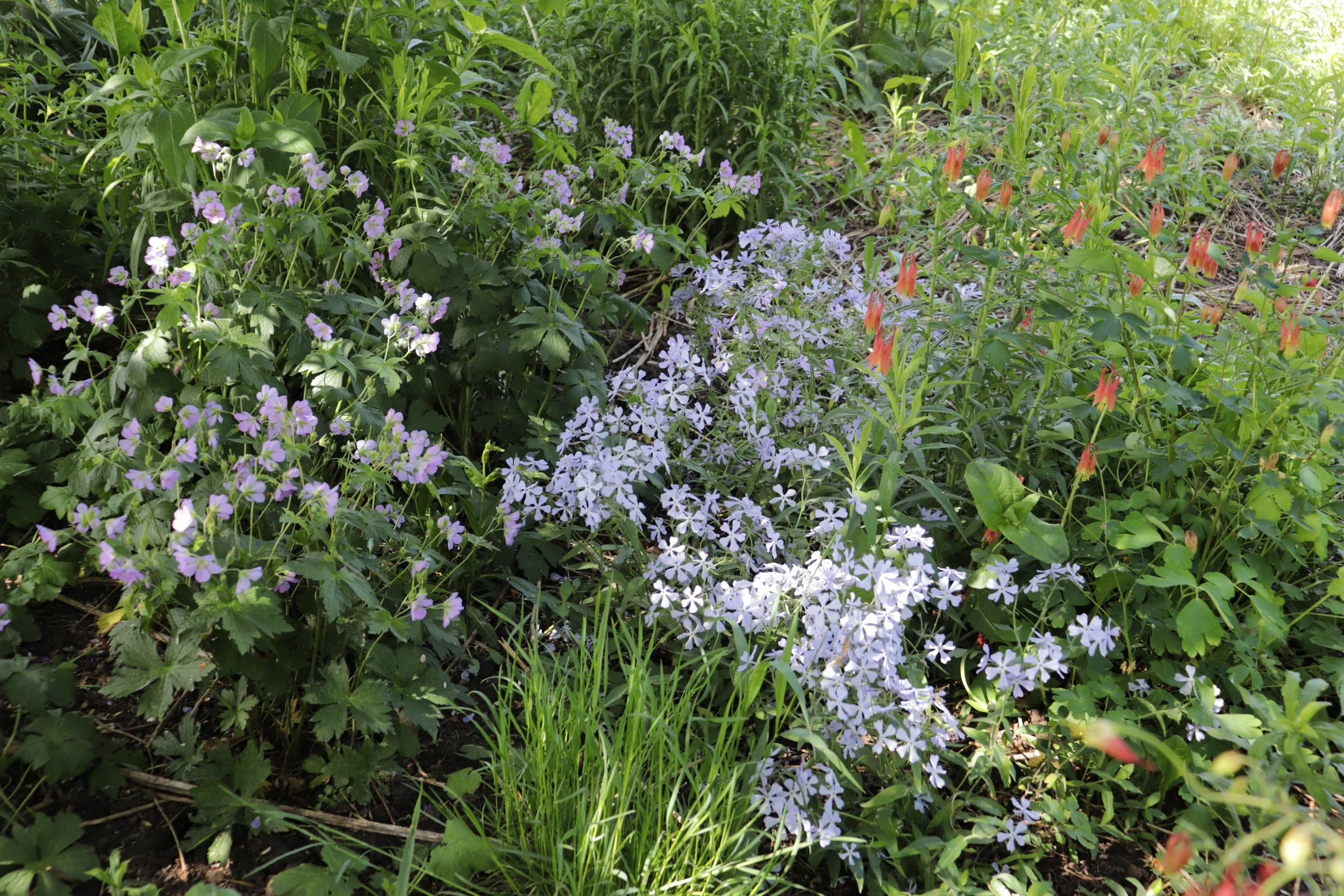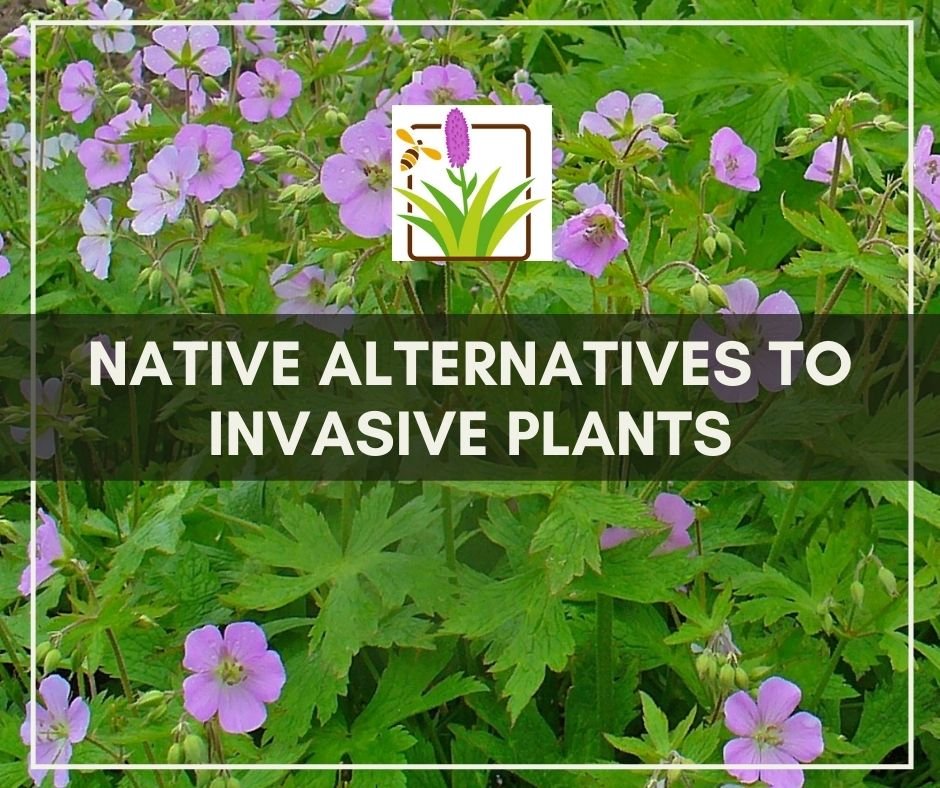Secrets To A Low Maintenance Garden
| Create a low maintenance garden by working with nature|
Gardeners are going to find a lot of advice out there about how to create the perfect, low maintenance garden. Much of the advice will inevitably lead gardeners to invest in counterproductive and labor intensive measures such as: laying plastic landscape fabric, hauling yards of wood mulch every year, installing costly irrigation systems and even choosing plants simply because they are labeled as ‘low maintenance groundcovers’ (which usually turn out to be invasive. I’m looking at you, Periwinkle!).
Some of these methods are futile, some are counter productive and some are just not necessary at all.
For example, weeds will eventually end up growing on top of, and through, the landscape fabric which makes both the weeds and fabric much harder to remove. The wood mulch eventually breaks down enough to create the perfect germination site for weed seeds. Plus, it requires a lot of work to spread!. The irrigation system is, to be upfront, a waste of money at best. If the right plants were chosen for the site then irrigation is not needed and can actually be harmful! Finally, many invasive groundcovers, such as Periwinkle, Goutweed and Bugleweed (all still sold in most garden centers), may seem like a good idea at first but when (notice I didn’t say IF) they spread out of control, you are going to be faced with an uphill battle trying to get rid of them.
All of these methods are counter productive because they are working against nature, not with it! As natural gardeners, we choose to work with nature which gives us the freedom to part from the above methods and truly reach the pinnicle of a low maintenance garden.
Note that LOW maintenance does not mean NO maintenance. After all, a garden by definition is a curated space, but the following tips will help you create a garden that requires less curation that traditional horticulture.
Five steps to a low maintenance garden:
1) Prepare Your Site With Care
Start your garden off on the right track and invest in proper and thorough site preparation.
The whole idea behind proper site prep is to create a weed free growing bed for your future plants to thrive in. Not doing so means that your baby plants could potentially be overwhelmed with an invasion of weeds.
Best case scenario if you don’t prepare your site properly: You will be subject to endless hours of weeding between sensitive new transplants until they establish and can take care of themselves. If you have ever tried to weed the garden while trying to decipher what you planted from what is a weed, then you know how this feels.
Worst case scenario: You will find yourself dealing with stunted or dead plants and a incoherent design that looks more like a weedy vacant lot than a garden. This is going to take a lot more work to fix than if you had just taken the time to get rid of weeds in the beginning.
Save yourself the headache and give your plants the head-start they deserve by investing in proper site prep. Choose the best method for your situation, whether its laying an ugly black tarp over the site for 6 months, sweating it out with a sod cutter or collecting heaps of cardboard for the lasagne mulch method.
Take the time to do site prep properly, even if you have to postpone your planting until fall or the next spring. Trust me, you won’t be sorry you did.
2) Choose The Right Plants
These Harebells demonstrate how there is an appropriate plant for any growing condition.
The number one mistake that I see native plant gardeners make is choosing the wrong plants for their yard. The truth is that poorly chosen plants/plant communities will eventually require unsustainable amounts of time, effort and money to prop up. This is definitely not low maintenance!
On the other hand, properly chosen plants will have the opposite approach and help you create a much more low maintenance garden.
The best way to choose the right plants is to first understand your site conditions including (but not limited to) sunlight, soil type, moisture levels and what ecozone your site is in. Next, choose the native plant community that your site most closely resembles and design your plant choices around species that would naturally grow there.
For example, if your front yard is sunny and dry, with clay soil then you’re most likely going to want to choose plants that thrive in an upland prairie ecosystem. No matter how much you want Marsh Marigold to grow there, it not going to happen unless its given constant attention.
Even the harshest of sites have plants that will thrive there - you just have to do your research. Look at the picture of Harebells I have included here. They are thriving in shallow ( <15cm deep), compacted, gravelly soil at the edge of a limestone pathway. They receive little to no attention and are only in their first full season yet they are thriving!
I understand that many of us are used to going to the nursery and buying whatever visually appeals to us (I’ve been guilty of this!) but the best way to come home with the right plants is to start out with a list of appropriate plants and stick to it! With this method, you are more likely to find the right plants for your specific site. With the right plants in hand, you are well on your way to having a garden that doesn’t rely on fertilizer, wood mulch, yearly replanting or supplemental watering to thrive.
Not sure how to choose the right plants? Check out our FREE Guide
3) More Plants, Fewer Problems
If you look carefully at nature, you will notice that bare ground usually doesn’t last very long before something is growing there. Think of construction sites, vacant lots or areas burned by wildfire - it is only a matter of a few weeks before plants have colonized these sites. This is natures way of healing itself after a natural or man-made disturbance removes vegetation.
The same laws apply to your garden which is part of nature too. Yet, all too often, gardens are dominated by neatly trimmed shrubs spaced out by a few feet of wood mulch or worse - bare soil! Any space in your garden that is vacant of plants is an invitation for weeds. If you don’t cover bare ground (mulch counts as bare ground) with a plant, nature will do it for you and more often than not this will be done by a weedy non-native species.
Any gardener who chooses to fight nature and maintain bare soil/wood mulch will need to get used to perpetual weeding and an inherently high maintenance landscape!
It is time to take lessons from nature and plant our gardens more densely. Natural garden designers seek to cover every square foot of garden space with a plant so weeds have no space to grow. This means layering your garden with a diverse mix of plants with different growth habits and forms. Groundcover plants are especially important and should be melded in between all other plants in your garden to form a ‘green’ or living mulch.
The topic of layering plants can fill up a whole article on its own so, for now, just remember: More plants, more plants, more plants.
4) Change The Way You Weed
The role of early successional weeds is to quickly cover and protect the soil.
Most common garden weeds are early successional species meaning their job in nature is to quickly colonize disturbed sites (whether they are natural like wildfire burn sites or man-made like freshly tilled soil) with the ‘goal’ of covering the ground and protecting the soil. These plants colonize, grow rapidly, then set thousands of seeds all in the span of one (annuals), sometimes two (biannuals), growing seasons. Their seeds fall to the ground and wait in anticipation in the soil (this is called a seed bank) for the next disturbance to bring them to the surface and expose them to light and moisture where they will proceed to grow again.
Proper site prep will certainly reduce the initial invasion of weeds on your site but your garden is still subject to natural succession and weeds will inevitably invade, especially during the first year or two of plant establishment.
Now, think about your main method of attack against weeds. It likely consists of digging up roots and disturbing the soil (like so many of us do). This process may bring short term gain but in reality it is creating the perfect conditions for weed seeds to germinate!
A low maintenance gardener has two preferred methods of weeding under his/her belt.
The first method is to take a sharp spade or garden knife (Hori Hori’s are great!) and slice the weeds’ roots under the soil at roughly a 45degree angle. Next, carefully remove the tool and proceed to pull the plant by hand. It should easily pop out without disturbing the soil as mush as digging a hole would have. This is an effective method for biannual weeds such as Common Burdock that are in their second year of growth, as it sets them back enough that they are not likely to produce seed that year (their final year of natural life) even if they grow back more leaves. Biannual weeds can mostly be eradicated within 2 or 3 seasons with this method (if used in conjunction with quickly replanting with desirable (native) species).
The second method is to simply grab some garden shears and cut the plant down to its base at soil level. Cut stems can be used as mulch if not bearing seeds or can be disposed of off-site if bearing seeds. This is effective for annual weeds, such as Lambs Quarters, because it stop them from producing seeds that same year (which is the only year of their lives as annuals). Annual weeds can be mostly eradicated within 1 or 2 seasons with this method of preventing seed production (if used in conjunction with quickly replanting with desirable species and avoiding further soil disturbance). This is the most effective method for garlic mustard eradication because digging them up and bringing more seeds to the surface will just prolong your suffering.
There are instances where digging might be the most effective tool, especially when dealing with aggressive or invasive perennials, but that is for another article.
5) Change Your Mindset
Nature knows best. It’s time to accept that it’s okay for plants to self-seed “out of line”.
Our environment is, always has been and always will be, in a constant state of flux and change. Whether that change comes from seasons, ecological succession, species adaptation or the climate, nature is never static. Even ecosystems (gardens) created by humans are subject to this rule and require specific and intensive maintenance practices to fight change.
Fighting change is a concept that has come to define mainstream horticultural practices. These practices promote a relentless desire for perfectly manicured lawns, neatly pruned boxwood hedges and rows of pansies that give most human-dominated landscapes a predictable, static look.
Any plant that self-seeds “out of line” is quickly weeded out, shrubs are confined to a certain shape and landscapes don’t change dramatically through seasons. This mindset of control creates a relentless struggle against the dynamic forces of nature and turns weeding, pruning, mowing and re-planting annuals into equally predictable, routine chores.
It is time to accept that nature is a dynamic, ever-evolving force and our choice to control it is what makes a garden high maintenance.
In natural garden design, seasonal change is not only embraced but is a foundational design element. Plant communities are allowed to express themselves by self-seeding and moving around the landscape over time to show us where they want to be. The Columbines you planted might have started off under your Serviceberry but they are self-seeders and will likely move around the garden over time to fill in gaps for you, free of charge (who can say no to free plants?). The Swamp Milkweed was possibly put in a spot that is too dry and will die out. However, it may re-seed into that wet hollow at the back of the garden as the silk on its seeds can carry it to new homes.
Your garden will always require input from you but when we embrace change rather than fight it, maintenance (keeping your garden in a static state) becomes management (guiding your gardens journey through small edits rather than forcing it in a certain direction).
Embracing this concept means that no garden will ever stay the same, but that is okay because it allows our gardens to evolve into the best versions of themselves.
Any other approach condemns a gardener to a lifetime of weeding and re-planting to keep plants in one spot.









